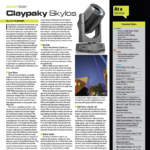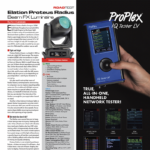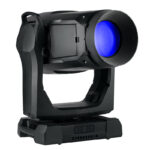HD to SDI, SD to SDI, VGA, YUV, RGB, HDMI, 3G — I find myself converting a lot these days. Because of the plethora of video signals that have developed in the last few years, techs, roadies and designers are having to come up with creative ways to get signal from point A to point B — on time and under budget.
That last part is the dirty word of video: budget. I can’t tell you how many times I’ve had to explain the radical differences in the price-to-quality ratio to a client who simply wants to see a decent result.
Last month, I had a look at the Ferrari of signal conversion, the Barco ImagePRO-II. (See “Road Test,” PLSN, May 2012, page 46). It comes with a list price at $11,200 (okay, maybe a bit less than your standard Ferrari).
What do you do when you can’t afford such a device, or — more to the point — don’t need to do all it can do? You turn to the growing variety of purpose-built, specific-action mini-converters. I’ve recently had the pleasure of using a few of these from Blackmagic Design.
 Small but Mighty
Small but Mighty
There’s a few reasons mini-converters are in just about every rental inventory in the country. A lot of rental houses are including them with camera/switching packages, thus extending the life of gear that’s already paid for, as well as providing an upsell in quality for their customers. They’re small, they’re rugged, and they solve problems. Rack space is at a premium in the studio and even more so on the road. Solved. Legacy devices need to interface with the latest/greatest. Solved. Budgets are pretty thin these days. Solved.
There was a time when a simple adapter would suffice, but, like I said, it’s more a matter of signal conversion than signal adaptation.
BMD has 10 separate models that all accomplish various tasks — four models that are under their “heavy duty” moniker and two that are battery-powered. The heavy-duty units are compact (4 by 3.5 by 1 inch in size) and all use a 12V external power supply. A big extra here was the fact that they all include a universal power supply with international socket adapters, so no worries for my friends abroad.
All can be upgraded with firmware/software patch via USB in either Mac OS X or Windows. All can be configured either by the external dip switches or via USB. Mini Converters feature the latest 3Gb/s SDI technology that operates at twice the data rate of normal HD-SDI. 3Gb/s SDI is also fully compatible with all SD-SDI and HD-SDI equipment, so you can connect to your existing equipment. Relevant models also use ¼-inch audio jacks and support embedded SDI and HDMI audio.
Mini Converters also detect the video input and automatically switch between formats, with redundant SDI inputs that are perfect for mission-critical live events, because you can run redundant cables for critical video paths. Should the primary connection fail, the Mini Converter switches instantly to the secondary connection — a big bonus for the rental/staging crowd.
My favorite thing about this entire line of converters is the lack of a need for a manual. I know, I know, that’s sacrilege. But they have the connection diagrams and dip-switch settings clearly printed on the outside of the unit. No menus to navigate, no questions to Google. The “Heavy Duty” units have all of these features, but are machined from a solid block of aircraft aluminum that can literally survive being run over by a broadcast truck.
In the Rack
 The Analog-to-SDI converter has proven invaluable for my work. It’s able to take Y/B-Y/R-Y, composite, or S video in and spit out a clean, pristine SDI signal along with analog (or AES) audio. This is great if you are using higher-end capture equipment with legacy analog equipment. It’s sister, the SDI-to-Analog converter, does the exact opposite.
The Analog-to-SDI converter has proven invaluable for my work. It’s able to take Y/B-Y/R-Y, composite, or S video in and spit out a clean, pristine SDI signal along with analog (or AES) audio. This is great if you are using higher-end capture equipment with legacy analog equipment. It’s sister, the SDI-to-Analog converter, does the exact opposite.
Since I work in a venue that has fixed cable paths (not to mention fixed budgets), I can use the SDI-to-HDMI converter to send high resolution signal from control booth to stage using existing coaxial cable and utilize HD monitors on the other end.
The product line also includes a sync generator, a 1-by-8 SDI distro, a broadcast converter, and the one I think has the most potential — the Optical Fiber to SDI converter. Anyone who has ever been on a gig where you’re sequestered behind some drape in the back of a ballroom knows the hassle of getting signal to go the distance. God forbid you’re at an outdoor festival and need to run distances of 1,000 feet or more.
Since the advent of low-cost fiber conversion, you can use a couple of mini-converters with rugged, single-mode fiber and send high resolution signal with 16 channels of embedded audio distances that start with “kilo” instead of three digits.
Speaking of three digits, that’s what these cost, so you’ll never have to use that dirty word — “budget” — again.
Blackmagic Design Mini Converters
What They Are: Small, rugged, advanced audio/video signal converters
Pros: High quality signal conversion in a small package, universal power supply, clear signal diagrams printed right on the unit
Cons: Not very versatile — one task per unit. (But at this price, who’s complaining?)
How Much: $295-$995
Jeff Gooch, a.k.a. Projectionfreak, writes about large-format projection, projection mapping, video and all the technology that makes them go. His blog is at www.projectionfreak.com.



